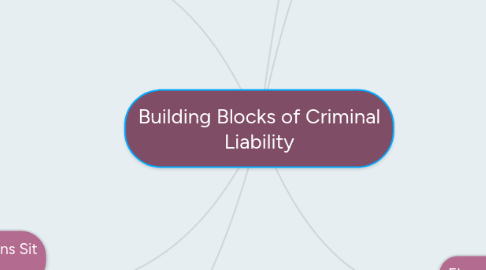
1. Actus Non Facit Reum Nisi Mens Sit Rea
1.1. An act is not criminal in the absence of a guilty mind.
2. Offences
2.1. Common Law Offences
2.1.1. Definitions to be found in decisions of Superior Courts.
2.1.2. [eg] Murder; Manslaughter
2.2. Statutory Offences
2.2.1. Definitions to be found in Acts of Parliament
2.2.2. [eg] Rape - Sexual Offences Act 2003; Criminal Damage - CDA 1971; Theft - Theft Act 1968/1978
3. Burden/Standard Of Proof
3.1. Woolmington v DPP (1935)
3.1.1. HOL had to consider if the fact that AR was satisfied = burden placed on D to prove killing was accident.
3.1.2. Held that burden of proof was never on D and never would be. Ppl are assumed innocent until proven guilty.
3.1.2.1. In respect of all elements of all offences, Burden of proof is on the prosecution.
3.1.2.1.1. AR - Burden of proof = Prosecution
3.1.2.1.2. MR - Burden of proof = Prosecution
3.1.2.1.3. Defences - Burden of proof = Prosecution to DISPROVE any defences
3.2. Beyond Reasonable Doubt?
3.2.1. Page 16 of the Crown Court Bench Book stipulates that: “The prosecution proves its case if the jury, having considered all the evidence relevant to the charge they are considering, are sure that the defendant is guilty. If the jury are not sure they must find the defendant not guilty”.
3.2.2. If the jury are sure that the defendant is guilty they should convict.
3.2.3. If the jury are sure that the defendant is not guilty they should acquit.
3.2.4. If the jury are unsure as to whether the defendant is guilty or not guilty they should acquit.
4. Purpose of elements in a crime = is to provide clear rules of conduct & a secure & fair basis for punishment.
5. Elements in Criminal Law
5.1. [ACTUS REUS] Prohibited Conduct ( External Element)
5.1.1. Comprises conduct, with/without a designated result, including the presence of any circumstances necessary for that conduct to be criminalised.
5.2. [MENS REA] Accompanying Mental Element (Internal Element)
5.2.1. Liability for serious crimes requires proof that the accused was blameworthy in doing what he did. This is because it is a fundamental ethical principle underpinning the criminal law that the State should only have authority to punish its citizens if they deserve it.
5.2.2. Blameworthy states of mind most commonly used to justify punishment:
5.2.2.1. 1. Intention
5.2.2.2. 2. Recklessness
5.2.2.3. 3. Dishonesty
5.2.2.4. 4. Knowledge
5.2.2.5. 5. Belief
5.3. Defences (Absence of Valid Defence, If any)
5.3.1. Defences are able to block criminal liability although the elements of the offence (actus reus and mens rea) are present.
5.3.2. Common Defences
5.3.2.1. Self Defence
5.3.2.1.1. although definition of offence is satisfied, act of accused not wrongful due to certain circumstances.
5.3.2.1.2. AKA justifications
5.3.2.2. Necessity
5.3.2.3. Automatism
5.3.2.4. Duress
5.3.2.4.1. "unfair to punish accused although act was wrongful" as H.L.A Hart said "they were deprived of the capacity or a fair opportunity to conform to the prohibition"
5.3.2.4.2. AKA excuses
5.3.2.5. Insanity
5.3.3. To rely on a defence there must not only be a good reason for the accused acting as they do, but also the accused MUST ACT FOR THAT REASON.

